Related Research Articles
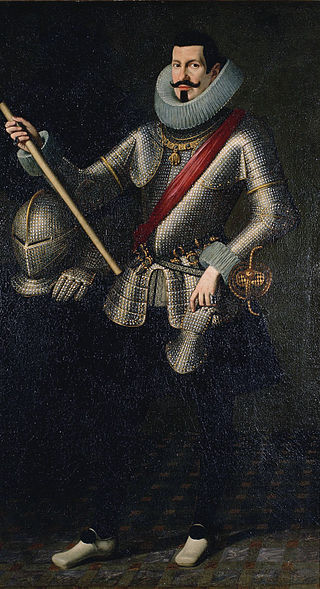
Pedro Téllez-Girón, 3rd Duke of Osuna was a Spanish nobleman and politician. He was the 2nd Marquis of Peñafiel, 7th Count of Ureña, Spanish Viceroy of Sicily (1611–1616), Viceroy of Naples (1616–1620), a Knight of the Order of the Golden Fleece since 1608, Grandee of Spain, member of the Spanish Supreme Council of War, and the subject of several poems by his friend, counselor and assistant, Francisco de Quevedo.

Alfonso de la Cueva-Benavides y Mendoza-Carrillo, marqués de Bedmar was a Spanish diplomat, bishop and Roman Catholic cardinal. He was born in Bedmar, in what is now the province of Jaén. Alfonso was the son of Luis de la Cueva-Benavides, 2nd señor of Bedmar, and Elvira Carrillo de Mendoza y Cárdenas.

Luis de Velasco y Ruiz de Alarcón was the second viceroy of New Spain during the Spanish colonization of the Americas in the mid-sixteenth century.
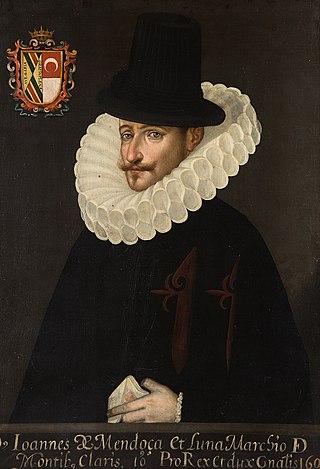
Juan de Mendoza y Luna, 3rd Marquess of Montesclaros was a Spanish nobleman, man of letters, and the tenth viceroy of New Spain. He governed from October 27, 1603 to July 2, 1607. Thereafter he was viceroy of Peru, from December 21, 1607 to December 18, 1615. After returning to Spain, he became advisor to the king and a high official in the Court.

Don Diego Carrillo de Mendoza y Pimentel, 1st Marquess of Gélves was a Spanish cavalry general, viceroy of Aragon, and viceroy of New Spain. He held the latter position from September 21, 1621 to January 15, 1624 or November 1, 1624.

Duke of Osuna is a Spanish noble title that was first awarded in 1562 by King Philip II of Spain to Pedro Girón de la Cueva,. Pedro was also Viceroy of Naples, (1582–1586), Ambassador in Portugal and 5th Count of Ureña.
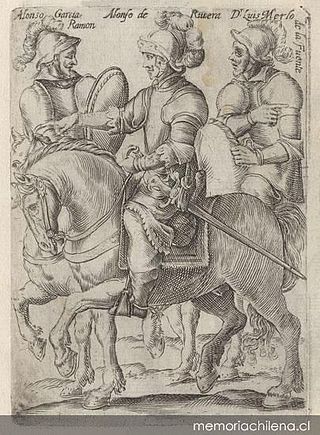
Luis Merlo de la Fuente Ruiz de Beteta was a Spanish colonial official who briefly served as the Royal Governor of Chile, in 1610–11.
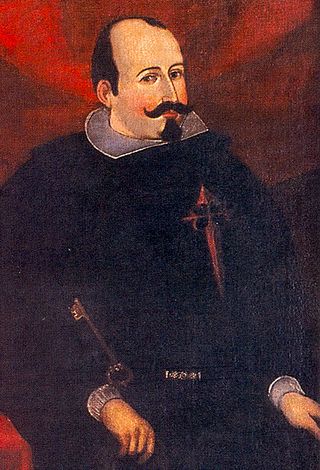
Luis Jerónimo Fernández de Cabrera Bobadilla Cerda y Mendoza, 4th Count of Chinchón, also known as Luis Xerónimo Fernandes de Cabrera Bobadilla y Mendoza, was a Spanish nobleman, Comendador of Criptana, Alcaide of the Alcázar de Segovia, Treasurer of Aragón, and captain general and Viceroy of Peru, from January 14, 1629, to December 18, 1639. His wife, Ana de Osorio (1599–1625), is credited as being one of the first Europeans to be treated with quinine, and as the person who introduced that medicine into Europe.
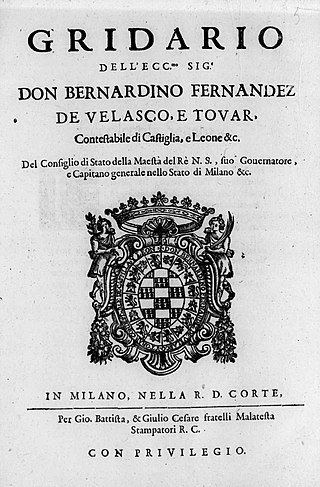
Bernardino Fernández de Velasco, 6th Duke of Frias, Grandee of Spain,, was a Spanish nobleman and diplomat.

Francisco Mendoza de Bobadilla was a Spanish Roman Catholic Cardinal.

Fadrique Álvarez de Toledo y Enríquez, 2nd Duke of Alba was a Spanish nobleman, military leader and politician.

Juan Francisco Pacheco y Téllez-Girón, 4th Consort Duke of Uceda,, was a Spanish noble, viceroy of Sicily and Spanish Ambassador in Rome.

Count of Chinchón is a title of Spanish nobility. It was initially created on 9 May 1520 by King Charles V, Holy Roman Emperor, who granted the title to Fernando de Cabrera y Bobadilla.

Íñigo López de Mendoza y Quiñones, was the 1st Marquis of Mondéjar and 2nd Count of Tendilla. He was known as El Gran Tendilla and was a Spanish noble of the House of Mendoza. He was the son of Íñigo López de Mendoza y Figueroa, 1st Count of Tendilla, and the grandson of the poet Íñigo López de Mendoza, 1st Marquis of Santillana.

Íñigo López de Mendoza y Mendoza was a Spanish noble, military, diplomat and politician in the service of King Philip II of Spain. He was the 4th Count of Tendilla and 3rd Marquis of Mondejar.

Don Fernando Girón de Salcedo y Briviesca, First Marques of Sofraga, born 1562, died 1630, was a Member of the Council of War for Flanders, and Maestre de Gampo General for Aragon with the Castellany of the Aljafería de Zaragoza, as well as Grand Chancellor and Bailiff of the Holy Sepulcher of the Order of Knights of the Hospital of Saint John of Jerusalem, and Gentleman of the Privy Chamber to Philip III and Philip IV of Spain. As governor he successfully defended Cádiz against the English in 1625, which led him to be immortalized in a painting of Francisco de Zurbarán, The Defence of Cadiz against the English.

Don Isidoro de la Cueva y Benavides IV or V Marquis of Bedmar, was a Spanish noble, military and politician. He was acting Governor of the Spanish Netherlands from 1701 to 1704, Viceroy of Sicily from 1705 to 1707 and Spanish Minister of War in 1709.
Pedro Vélaz de Medrano y Manso de Zúñiga, II Lord of Tabuérniga was the captain general of the Armada de Barlovento and custodian of the Spanish Treasure Fleet, seargent major, governor of the Tercio of Álava, governor of five galleons from Naples, squadron Admiral, General, a sailor and prominent Spanish noble during the reign of Felipe IV.
References
- 1 2 3 Burke, Marcus B.; Cherry, Peter (1997). "Juan de Mendoza, Marqués de San Germán and Marqués de la Hinojosa". In Gilbert, Maria L. (ed.). Collections of Painting in Madrid, 1601–1755 (Parts 1 and 2). Los Angeles: Getty Research Institute. p. 265. ISBN 0-89236-496-3 . Retrieved 2022-06-13– via Google Books.
- 1 2 Louis, Lloyd; Lloyd, E. M. (1894). "Marlborough and the Brest Expedition, 1694". The English Historical Review. 9 (33): 130–132. ISSN 0013-8266. JSTOR 547285.
- 1 2 3 4 Matilla Tascón, Antonio (1987). Catalogo de documentos notariales de nobles [Catalog of notarial documents of nobles] (in Spanish). Madrid: Hidalguia. p. 220. ISBN 978-84-00-06481-5 . Retrieved 2022-06-13– via Google Books.
- ↑ Conte, Angelo Lo (2020-12-30). The Procaccini and the Business of Painting in Early Modern Milan. Routledge. ISBN 978-1-000-29241-1.